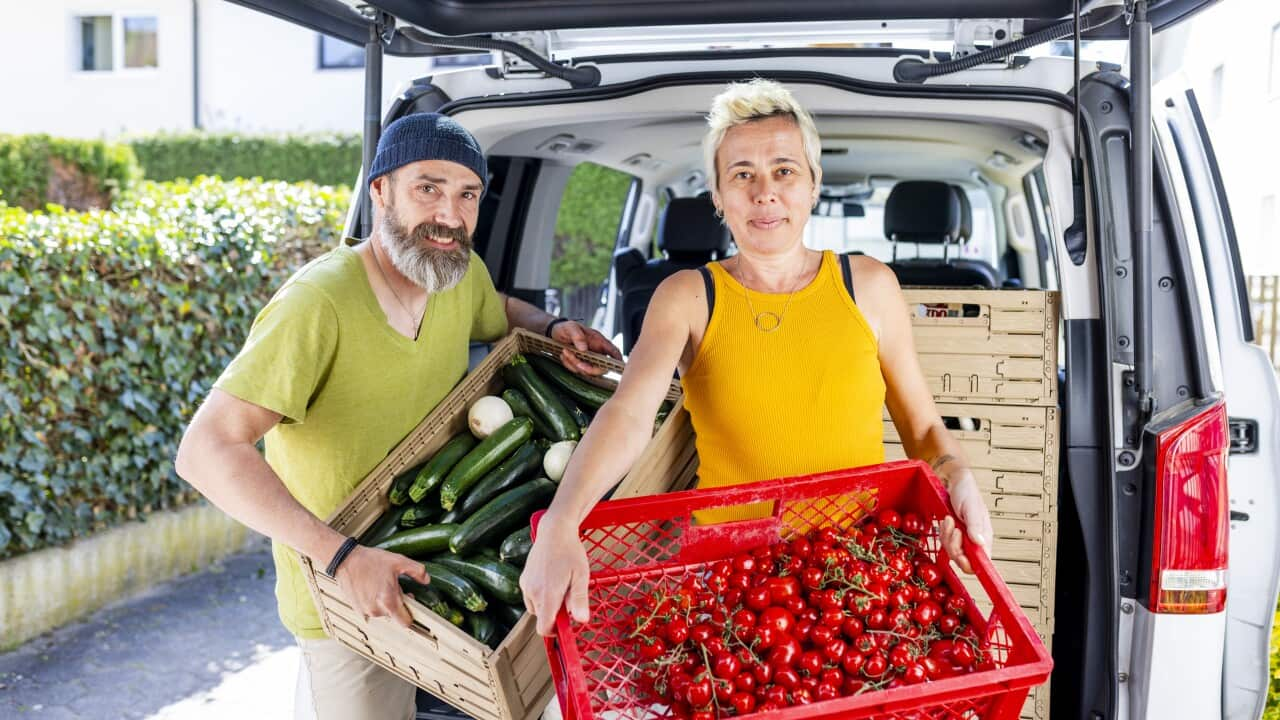Richard Byers ran a small wholesale business for over a decade, supporting his family in South Australia.
"We were earning around $300,000 per year, we were just selling and selling," he said.
But his fortunes changed when he was diagnosed with prostate cancer, and during his time away from the business, it collapsed.
"I lost contact with our clients, and we lost so much money, so we lost the business. Things just went from bad to worse," he said.
"No way in a million years did we think this would happen."

Richard and his wife Kimberly in a shed filled with boxes of artificial flowers — the product they used to sell before they lost their business. Source: Supplied / Lloyd Thornton
Richard and his wife Kimberly now drive 40 minutes to a nearby town to do their grocery shop at a mobile Foodbank van.
Low-income families living with 'daily anxiety'
Every year food relief charity Foodbank provides free and discounted groceries for thousands of families, creating millions of meals.
The organisation estimates 2.4 million households have run out of food in the last year.
Low-income households, earning less than $30,000 per year, are among the most vulnerable according to the Foodbank Hunger Report 2024 released today.
Foodbank surveys thousands of Australians each year about how they are coping with the costs of food and household items.

Every year Foodbank sources enough food to provide around 90 million meals.
Single-parent households are the most vulnerable, with 41 per cent regularly skipping meals or going entire days without food.
Families in regional Australia are 7 per cent more at risk of food insecurity than those in cities.
Since the onset of the cost-of-living crisis in 2022, there has been growing inequality between high and low-income households, the report said.

The divide between high and low-income households has widened in the past two years, with those under $30,000 per year much more likely to endure food stress.
Meanwhile, households earning over $95,000 per year have become more food secure.
In 2022 these higher-income households were 68 per cent food secure, but this number has risen to 79 per cent in 2024.
Foodbank Australia CEO Brianna Casey says low-income families have reached their limits.
"They are routinely skipping meals, compromising on the quality and nutrition of their food and going without personal care and household products," she said.
"This is no longer a crisis of temporary hardship but a prolonged, systemic issue affecting millions of Australians. These households live with the daily anxiety of not knowing where their next meal will come from."
Swapping seafood for mince
The Byers' family have made big changes to their spending habits to put food on the table.
"We used to go out, buy fish and chips and lunches outside, we don't do that anymore, we don't buy seafood anymore," Richard said.
The family of three do more cooking at home with simpler ingredients.
"We make shepherd's pie and that sort of thing," Kimberly said.
"For the mince they [Foodbank] charge us $2.50 for a kilo of mince, and then the potatoes are free. So, you get a huge meal for a couple of dollars."
The pair say Foodbank is much cheaper than the major supermarkets.
"We bought a whole chicken for $5, that was two meals for the three of us," Richard said.
"That would cost $12 or $15 at a big supermarket.
"You can take bread and vegetables like potatoes, carrots, cauliflowers, all that sort of stuff. It's all free. So, we load up with that — enough for a fortnight."

Richard Byers said "no way in a million years" did he think he and his family would have lost their business and fallen into food insecurity. Source: Supplied / Lloyd Thornton
Family and friends can't fill the gap
Australia's charities continue to grapple with historically high demand for food relief.
Food insecure households are receiving food relief more often as they struggle to cope, with 53 per cent seeking food relief more often than a year ago.
Increasingly family and friends are no longer able to help.
Only a quarter of food-insecure households have support from friends and family, down from a third in 2023.
"This is an alarming statistic that demonstrates just how desperate the situation has become for those who were once a lifeline no longer in a position to extend help to loved ones and friends," Casey said.
"We know it’s going to take months, if not years, for many families to bounce back."











